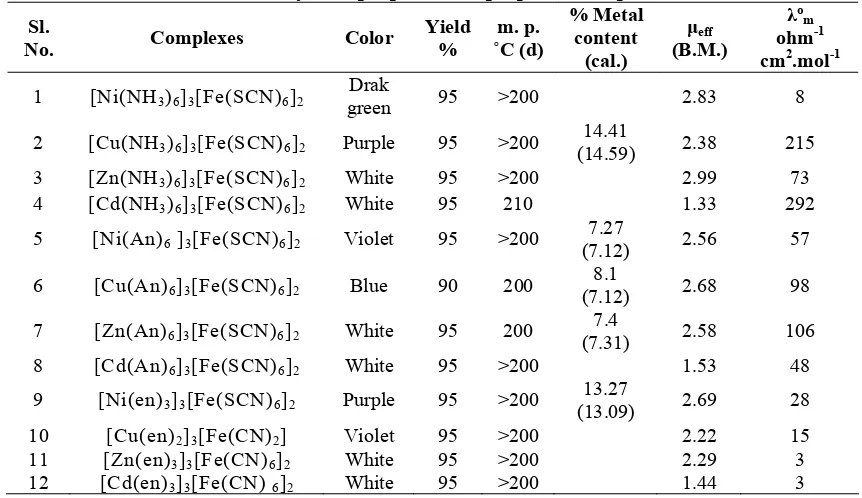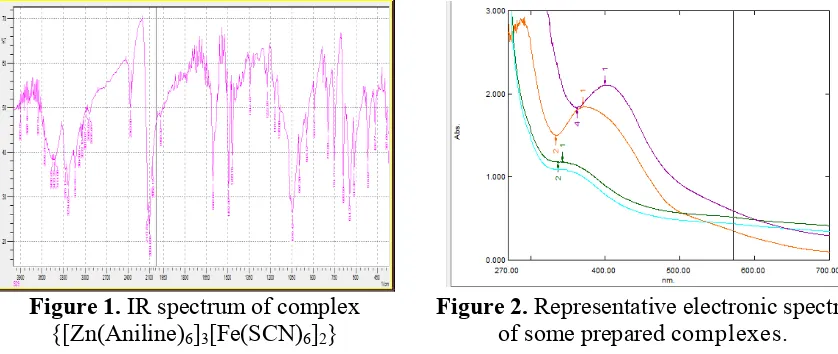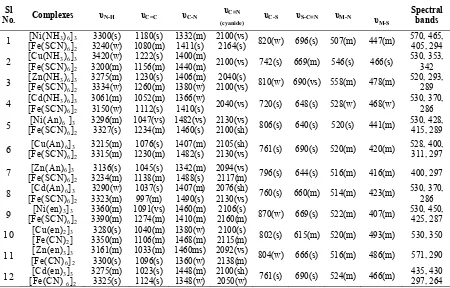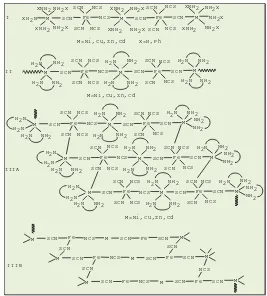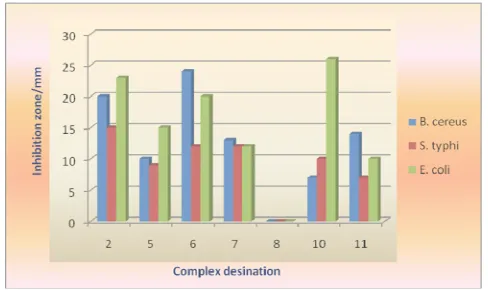The journal homepage www.jpacr.ub.ac.id ISSN : 2302 ‐ 4690
99
Bimetallic Heteronuclear Complexes Bridged With
Ferrichexathiocyanate: Synthesis, characterization and
antibacterial properties
Mohammad Nasir Uddin*, D A Chowdhury, Jashmin Akter
Department of Chemistry, University of Chittagong, Chittagong-4331, Bangladesh
*
Corresponding email: [email protected]
Received 20 January 2014; Accepted 20 April 2014; Revised form accepted 13 August 2014; Published online 1 September 2014 for edition September-December 2014
ABSTRACT
A number of heterobinuclear thiocyanato-bridged complexes of cations, [M(NH2X)6]2+ and
[M(en)3]2+ (where en= Ethylenediamine, X = H, Ph; M= Ni, Cu, Cd, Zn), with
ferrichexathiocyanate have been prepared. The complexes have been characterized by
FT-IR, 13C NMR and UV-vis spectroscopy, metal analysis, magnetic and conductance studies.
The composition complexes has been proposed on the basis of experimental and literature evidences. The antibacterial activity of the prepared complexes has also been investigated against the gram positive-Bacillus cereus and gram negative- Salmonella typhi and Escherichia coli pathogens.
Keywords: Bimetallic thiocyanato-bridged complexes, ferrichexathiocyanate ethylenediamine, antibacterial properties.
INTRODUCTION
Bimetallic species occupy an important position in modern inorganic chemistry. They play an important role in biological processes like activation of enzymes by metals [1]. Such complexes are useful in the storage and transport of active substances through membranes [2].
The linear triatomic pseudohalide thiocyanate ion, SCN-, an ambidentate ligand with two donor atoms, may act as a rigid bridged ligand and link a pair of metal centers through 1,1-μ-SCN, 1,1-μ-NCS or 1,3-μ-SCN configuration to satisfy the coordination number of the metal ion [3,4]. Based on the bridging function of the thiocyanato group, two novel complexes formulated as [{(Cu(bpy)2)2OH}(Cr(NCS)6)].H2O, (bpy= 2,2′-bipyridine) and [{(Cu(PMDT))2OH} (Cr(NCS)6)].H2O (PMDT = 1, 1, 4, 7, 7-pentamethyl diethylenetriamine) have been synthesized [5]. Francese et al. [6] used a macrocyclic copper(II) complex Cu(cyclam)2+ (cyclam=1,4,8,11-tetraazacyclotetradecane) to obtain a heterometallic system bridged by a thiocyanate group. Xiang et al. [7] prepared the [Zn(bipy)3][Zn(SCN)4] complex and characterized by X-ray diffraction analysis. A series of heterobinuclear thiocyanato-bridged complexes including (CuL1)3[Fe(NCS)6]2.3H2O and (NiL2)3[Fe(NCS)6]2·2H2O (where L1 = 5, 12-dimethyl-[14]-1,4,8,11-tetraazacyclotetradeca-4,11-diene; L2 = 5,7,12,14-tetramethyl-[14]-1,4,8,11-tetraazacyclotetradeca-4,11-diene) have been characterized by Tomkiewics et al. [8] where copper(II) and nickel(II) are connected with two different thiocyanate groups.
The journal homepage www.jpacr.ub.ac.id ISSN : 2302 ‐ 4690
100 chemistry of heteronuclear complexes though such complexes show some exceptional structural behavior especially when one of the metals is iron. In our laboratory different aspects are attempted to synthesize and characterize the heteronuclear complexes having [Co(NCS)4]2-, [Ni(NCS)4]2- and [Hg(NCS)4]2- anionic units [9-11]. In continuation of our research the synthesis of thiocyanato-bridged heteronuclear complexes with [Fe(NCS)6]3- unit have been reported herein. The antibacterial activities of some of the prepared complexes also have been investigated.
MATERIALS AND METHODS Chemicals
Ethylenediamine, aniline, methanol, chloroform and N, N-dimethylformamide (DMF) were obtained from Aldrich Chemical Company Ltd. Ammonium nitrate and potassium ferric hexathiocyanate were obtained from M|S Merak (Germany). Nitric acid, sulphuric acid and ammonia were obtained from BDH Chemicals Ltd. All chemicals except solvent were used as received. Solvents were dried by standard methods and distilled under an inert atmosphere. Using N, N-dimethylformamide (DMF) as the solvent, solutions of the complexes (of the order of 10-3 M) were used for conductivity measurements.
Analytical Methods
The analyses of the metal contents of the prepared complexes were done by Atomic Absorption Spectrophotometer (model Thermo Scientific ICE-3000) from Biological Laboratory of Chittagong University, Chittagong. The infrared spectra of the prepared complexes were obtained by FTIR spectrophotometer (Model- 8900, Shimadzu, Japan) using KBr as the matrix in the range 400-4000 cm-1 from research laboratory of the Department of Chemistry, C.U. Chittagong. Polystyrene was used as the standard to calibrate the spectrophotometer. Electronic absorption spectra were run on Shimadzu UV-Visible Recording Spectrophotometer (Model-1800) using 1 cm cells. An electro thermal melting point apparatus was used for the determination of the melting or decomposition points of the complexes. Conductivity measurement was performed on a Philips Conductivity Meter (Model-HI 9255). Determination of conductivity of an electrolytic solution involves measuring of the electrical resistance of that solution at a particular temperature, usually 25ºC. Magnetic susceptibility values of the prepared complexes were determined using the Magnetic Susceptibility Balance, (Sherwood Scientific) from the Laboratory of Inorganic Chemistry, Chittagong University, Bangladesh.
Preparation of Bimetallic Complexes, [M(L)x]3[Fe(NCS)6]2
Preparation of [Fe(NCS)6]
3-A 3 mmol (0.81 g) ferric chloride (FeCl3) was dissolved in about 60 mL water in a beaker. Then a slight excess NH4SCN was added dropwise. A clear solution of [Fe(NCS)6] 3-was formed.
[M(L)x]2+ solution
In another beaker, 2 mmol (0.589 g) of water soluble metal salts, chloride, nitrate or sulphate was dissolved in 50 mL water. An excess amount of conc. ammonia, aniline or ethylenediamine (en) was added to it drop wise. The mixture was heated to boil for about 12-15 minutes.
[M(L)x]3[Fe(NCS)6]2
The journal homepage www.jpacr.ub.ac.id ISSN : 2302 ‐ 4690
101 sometimes and allowed to cool with frequent stirring. The precipitate was formed almost immediately and the solid product formed was filtered off and washed with water and dried over calcium chloride.
A possible reaction for the preparation of mixed metal complexes 1. MCl2 + L (excess) ' M(L)xCl2
2. FeCl3 + 6NH4SCN ' (NH4)3[Fe(SCN)6] + 3NH4Cl Then from 1 and 2,
3M(L)xCl2 + 2(NH4)3Fe(SCN)6 ' [M(L)x]3[Fe(NCS)6] + 6NH4Cl [L= NH2X (X=H, Ph), n=6; L=en, n=3, M= Ni, Cu, Zn, Cd]
The bimetallic complexesprepared by the procedure as stated above are given in Table 1.
Test For of Antimicrobial Evaluation
Some of the synthesized complexes were screened for their antibacterial activity against different types of bacteria, gram positive- Bacillus cereus and gram negative- Salmonella typhi, Eschericahia coli regarded as pathogen to man, by the agar well diffusion method [12]. All media and bacteria suspension were prepared using a suitable method. The bacteria were grown in nutrient broth at 37OC for 24 hours. The complexes were tested using diffusion on solid media. Sterile (5 mm) diameter sensitivity paper disc were impregnated with concentration of dimethyl formamide (DMF) and their bimetallic complexes at concentration of 50 μg cm-3 and placed in the nutrient agar. The plates were then incubated for 24 hours. The results were recorded by measuring the growth inhibition (% zones of inhibition) surrounding the disc.
Table 1. Physical properties of prepared complexes.
Sl.
No. Complexes Color
Yield %
m. p.
˚C (d)
% Metal content
(cal.)
μeff
(B.M.)
λºm
ohm-1 cm2.mol-1
1 [Ni(NH3)6]3[Fe(SCN)6]2 Drak
green 95 >200 2.83 8
2 [Cu(NH3)6]3[Fe(SCN)6]2 Purple 95 >200 14.41
(14.59) 2.38 215
3 [Zn(NH3)6]3[Fe(SCN)6]2 White 95 >200 2.99 73
4 [Cd(NH3)6]3[Fe(SCN)6]2 White 95 210 1.33 292
5 [Ni(An)6 ]3[Fe(SCN)6]2 Violet 95 >200 7.27
(7.12) 2.56 57
6 [Cu(An)6]3[Fe(SCN)6]2 Blue 90 200 8.1
(7.12) 2.68 98
7 [Zn(An)6]3[Fe(SCN)6]2 White 95 200 7.4
(7.31) 2.58 106
8 [Cd(An)6]3[Fe(SCN)6]2 White 95 >200 1.53 48
9 [Ni(en)3]3[Fe(SCN)6]2 Purple 95 >200 13.27
(13.09) 2.69 28
10 [Cu(en)2]3[Fe(CN)2] Violet 95 >200 2.22 15
11 [Zn(en)3]3[Fe(CN)6]2 White 95 >200 2.29 3
12 [Cd(en)3]3[Fe(CN) 6]2 White 95 >200 1.44 3
RESULTS AND DISCUSSION Discussion on Preparation
The journal homepage www.jpacr.ub.ac.id ISSN : 2302 ‐ 4690
102 a different metal complex in the molar ratio 2:3. All the complexes were obtained almost immediately after mixing of the component metal complex solutions. During preparation of {[Cd(aniline)6]3[Fe(SCN)6]2} complex mixture was heated to dissolve the oily layer formed due to the presence of aniline. All the complexes are insoluble in chloroform. Some of them are moderately soluble in methanol. All complexes are highly soluble in DMF and stable at air. The metal analysis data indicate formation of the desired complexes with 3:2 molar ratio of the complex cation and the complex anion. Some physical properties of prepared complexes and spectral properties (FTIR, electronic) of prepared complexes are given in Table 1 and Table 2, respectively.
Qualitative Characterization
A little amount of the prepared complexes was taken in a test tube. Then concentrated nitric acid (HNO3) was added to the sample and gently warmed on a water bath for the decomposition. The solution was used for the qualitative characterization of metal ions.
Greenish white precipitate or coloration confirms Cd2+ ion with the addition of a few drops of potassium ferrocyanide, [K4Fe(CN)6] to the acidic sample. If copper is present, a maroon precipitate of Cu2Fe(CN)6 will appear and the coloration confirms Cu2+ ion.
The appearance of a dark red color due to the formation of Fe(SCN)3 complex ion confirms the presence of Fe3+ iron when a few drops of KSCN, 1 mL of HCl (conc.) and 2 mL of H2O are added to a test tube.
Acidifying with CH3COOH and the solution was made slightly alkaline with NH4OH. a red solution of nickel(II) dimethylglyoxime should appear with the addition of a few drops of alcoholic dimethyglyoxime confirming the presence of nickel.
In the solution, NaOH is carefully added in a drop wise, white Zn(OH)2 will precipitate and if excess NaOH is added it is dissolved that confirms the presence of Zinc ion.
The Ni2+ and Fe3+ ions can be separated by adding ammonia. The Ni2+ ion is converted to the deep-blue complex ion, Ni(NH3)62+, which stays in solution. While the Fe3+ ion, which does not readily form a complex ion with ammonia, is re-precipitated as iron(III) hydroxide.
Infrared spectra
The journal homepage www.jpacr.ub.ac.id ISSN : 2302 ‐ 4690
103 assignment of νCu-S vibrations is only tentative because of low intensity of these bands [4]. For all the complexes, the presence of υM-N and νM-S vibration in the same region 407-558 cm–1 confirms coordination and N-, S-donor character of the ligands to the metal ion. Furthermore, the presence of bands in δ(NCS), ν(C-S), ν(M-N) and ν(M'-S) regions are diagnostic for the nature of thiocyanate bonding [15]. A representative IR Spectrum of {[Cd(en)2][Ni(SCN)4]} has been given in Figure 1.
Figure 1. IR spectrum of complex {[Zn(Aniline)6]3[Fe(SCN)6]2}
Figure 2. Representative electronic spectra of some prepared complexes.
The Electronic Spectra
The visible ultraviolet spectroscopy is a simple but powerful tool for the interpretation of chemical bonds and structure of most chelates. Because of the insolubility of the presently prepared complexes in common organic solvents, the spectra of the prepared complexes were run in dimethylformamide. The bands at around 530 nm in the visible region for the prepared complexes can be assigned to d-d transition. The peaks observed below 350 nm are assumed as due to π→π*, n→π* and n→σ* transitions. And the peaks observed at 420 nm may be assumed as due to the presence of ferrichexathiocyanate. Figure 2 shows the representative electronic spectra of some prepared complexes.
13
C NMR Spectra
Splitting of the 13C NMR signal approximately at 132.5 (δ) for the complex, [Zn(Anil)6]3[Fe(NCS)6]2 indicates the presence of both nonbridged and bridging thiocyanate. In addition multiplet at 135(δ) complies with phenyl group of aniline.
Magnetic Measurements
The journal homepage www.jpacr.ub.ac.id ISSN : 2302 ‐ 4690
104 weak bonds and longer bond lengths may hide or prevent possibility of exchange interactions.
Table 2. Spectral properties of prepared complexes.
Sl
Molar conductance
The molar conductance values of the presently prepared complexes (ca. 10-3 M) are shown in Table 6.3. The low conductance values 03-106 ohm-1cm2mol-1 of the prepared complexes in DMF solutions corresponding to 3:2 electrolytes strongly support proposed formulation of the prepared complexes of nonelectrolytic nature. This suggests oxidation states of the metal ions present in such complexes. The high conductance values of the [Cu(NH3)6]3[Fe(SCN)6]2 and [Cd(NH3)6]3[Fe(SCN)6]2 complexes in DMF solutions indicates their electrolytic nature that strongly supports their ionic formulation due to the electrostatic attraction of both cation and anion.
Geometry
Compound [Ni(en)2]4[Fe(CN)5NO]2[Fe(CN)6].5H2O is obtained by reaction of [Fe(CN)5NO]2- with [Ni(en)3]Cl2 in aqueous solution. The slow dissociation of [Ni(en)3]2+ into [Ni-(en)2]2+ leads to the growth of crystals suitable for X-ray diffraction [3,15]. It is supposed that heterobinuclear thiocyanato-bridged complexes have been synthesized by the reaction of cations, [M(NH2X)6]2+ and [M(en)3]2+ with anion [Fe(NCS)6]3–. Complexes having the compositions, [M(NH2X)5]3[Fe(NCS)6]2, and {[M(en)2]3[Fe(NCS)6]2}n (where M=Cu, Ni, Zn, Cd; X= H, Ph) are prepared.
The journal homepage www.jpacr.ub.ac.id ISSN : 2302 ‐ 4690
105 3M(en)3Cl2 + 2(NH4)3Fe(SCN)6 '{[M(en)2]3[Fe(NCS)6]2}n + 6NH4Cl
Bridge geometry was also confirmed by the 13C nmr of the complex, [Zn(aniline)5]3[Fe(NCS)6]2 when splitting of peak at (δ) 123.5 indicates the bridging thiocyanate and that multiplet at (δ) 135 comply with phenyl group of aniline.
Figure 3.
M-SCN-Fe-NCS-M-SCN-Fe-The journal homepage www.jpacr.ub.ac.id ISSN : 2302 ‐ 4690
106 CNS-M unit. Which are cross linked to give polymeric ribbons {[M(en)2]3[Fe(NCS)6]2 }n as shown in Figure 3 (III). This proposed polymeric formulation is confirmed by the structure of Bimetallic assemblies, [Ni(en)2]3[M(CN)6]2·3H2O. When authors proposed that both cis and trans [Ni(en)2] and [M(CN)6] moieties are linked to give S-shaped Ni-NC-M-CN-Ni-NC-M-CN-Ni units which are cross linked to give ribbons [18]. But actual geometry is difficult to elucidate without crystallographic studies. Figure shows the proposed schematic view of complex, [{M(en)2}{Ni(NCS)4}]n.
Effect on the bacterial growth
In the present work, some of the prepared complexes were selected for antibacterial activity against three human pathogenic bacteria. The results of antibacterial activity of the test organismsfor different complexes are graphically presented in Figure 4.
Figure 4. Graphical
presentation of antibacterial activity of the prepared complexes.
It is found that, except [Cd(An)6]3[Fe(SCN)6]2 all compounds are comparatively more effective against Eschericahia coli. The remaining complexes are generally quite effective against Bacillus cereus except [Cd(An)6]3[Fe(SCN)6]2, [Cu(en)2]3[Fe(CN)2] and all are moderately effective against Salmonella typhi. The enhanced activity of the complexes can be explained in terms some important factors such as nature of the metal ion, metal ion coordinating site, hydrophilicity, hypophilicity and presence of coligands may have considerable influence on the antibacterial activity. The chelate complexes may deactivate various cellular enzymes which play vital role in various metabolic pathways of these microorganisms. Other factors such as solubility, conductivity and dipole moment affected by the presence of metal ions, may be the reasons for the increased biological activities of the metal complexes. Therefore the antibacterial activity of the metal complexes cannot be ascribed to chelation alone but it’s an intricate blend of all of the above contributions.
CONCLUSION
The journal homepage www.jpacr.ub.ac.id ISSN : 2302 ‐ 4690
107 Further works are required to exploit and ascertain such possibilities. From comparative study, the prepared complexes have been found to be quite effective against selected human pathogenic bacteria.
REFERENCES
[1]. Chandra, S. and Tyagi, M., J. Indian Chem. Soc., 2008, 85, 42-47.
[2]. Prasad, R. N., Sharma, K. M. and Agrawal, A., J. Indian Chem. Soc, 2007, 84, 1266-1268.
[3]. Bai, Y., Shang, W. L., Dang, D. B., Acta. Cryst. 2007, E63, 2628.
[4]. Zhou, J.H., Peng, Y.F., Zhang, Y.P., Li, B.L., Zhang Y., Inorg. Chem. Commun., 2004, 7, 1181-1183.
[5]. Dobrzañska, L., Wrzeszcz, G., Grodzicki, A. and Rozploch, F., Polish J. Chem., 2000,
74, 1017-1023,
[6]. Francese, G., Ferlay, S., Schmalle, H. W. and Decurtins, S., New J. Chem., 1999, 180, 267-269.
[7]. Xiang, H., Zhong, L. C. and Zheng, Z. Q., Chinese J. Struct. Chem., 2005, 24 (2), 159-162.
[8]. Tomkiewicz, A., Klak, J. and Mrozinski, J., Materials Science-Poland, 2004, 22(3),
253-263.
[9]. Uddin, M. N., Rupa, T. S., Bull. Ethiopian Chem. Soc., 2014,Accepted. [10]. Uddin, M. N., Rupa, T. S., J. Applied Chem. Res., 2013, Accepted.
[11]. Uddin, M. N., Chowdhury, D. A., and Islam, J., Chiang Mai J. Sci., 2013, 40 (4), 625-633.
[12]. Uddin, M. N., Chowdhury, D. A., Islam, M. T., Hoque, F., Orbital-Elec. J. Chem.,
2012, 4 (4), 273-280.
[13]. Kooti,M., and Noori, Z., J. of Appl. Chem. Res., 2010, 4 (14), 47-52.
[14]. Banerjee, S., Wu, B., Lassahn, P., Janiak, C. and Ghosh, A., Inorg. Chim. Acta, 2005, 358, 535-544.
[15]. Upadhayay, N., Chem. Sci. Trans., 2013, 2 (2), 455-563.
[16]. Skorupa, A., Korybut-Daszkiewicz, B., Mroziński, J., Inorg. Chem. Acta, 2002, 336, 65-70.
[17]. Colacio, E., Ghazi, M., Stoeckli-Evans, H., Lloret, F., Moreno, J. M. and Pérez, C. Inorg. Chem., 2001, 40, 4876-80.
